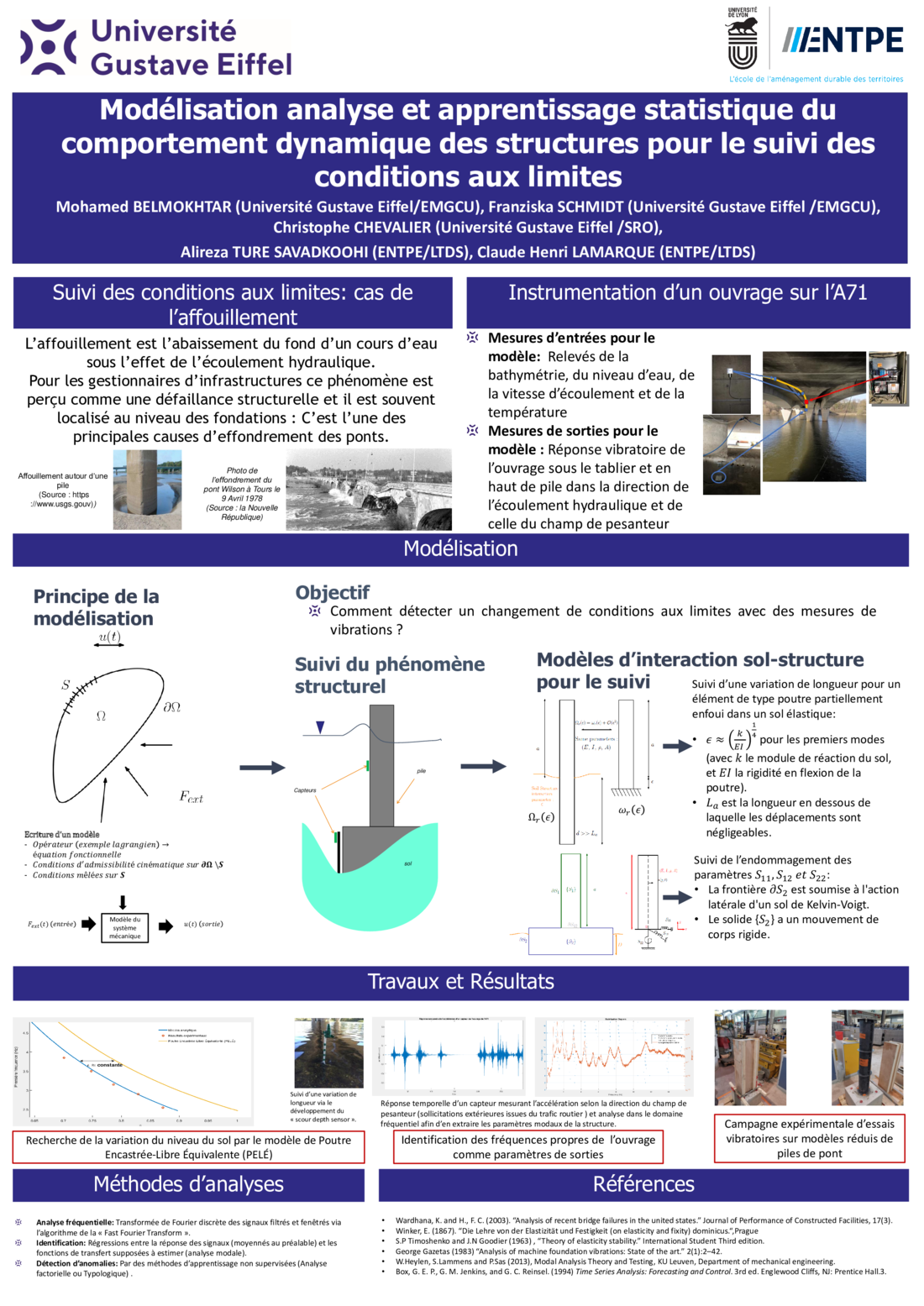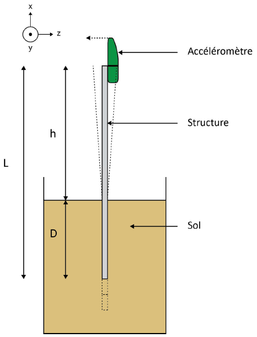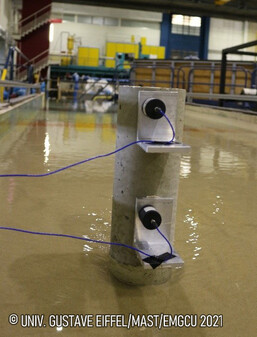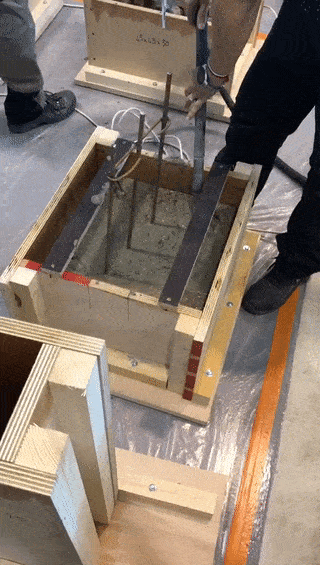Vulnerability of structures to the risk of scouring
Introduction
Scour is the removal and transport of sediment from the bed of a watercourse under the erosive action of a hydraulic flow. This phenomenon is increased by the presence of obstacles to the flow, such as bridge piers and abutments, or, also, offshore wind turbines, in a maritime context. The presence of scour holes in the area of the supports of the structures causes a loss of bearing capacity of these structures and can threaten their stability.
Scour is considered to be the main cause of structural failure in many countries. In the United States, for example, it is estimated that more than 50% of failures are caused by hydraulic phenomena, including scour. In France, the collapse of the Wilson Bridge in Tours in 1978, and more recently in 2007, the collapse of the Saint-Etienne River bridge on Réunion Island, are two national examples of the disastrous consequences of this phenomenon.
Faced with this hydraulic risk, it is crucial to continuously monitor the evolution of the scour depth at the piers and abutments of engineering structures. Several instruments have been developed and tested on site over the last twenty years. However, the deployment of these tools on site faces various problems, in particular, sensitivity to interference, vulnerability to debris, low resolution, cost, installation and maintenance difficulties, tedious post-treatments, etc.
The need for new non-destructive techniques for monitoring structures has led some authors to examine the feasibility of scour monitoring at bridges using various dynamic monitoring techniques.

National project ANR SSHEAR
The ANR SSHEAR project (2014 - 2018, https://sshear.ifsttar.fr/ ) focused on improving knowledge on scouring mechanisms and developing innovative observation and modelling tools on the scale of both experimental models and full-scale structures with the aim to propose diagnostic, warning and management methods.
Two engineering structures were instrumented, a prestressed concrete bridge on Loire river and a masonry railway structure. Two videos can be viewed on the SSHEAR website showing these instrumentations.
PhD work « Vulnerability of engineering structures to the risk of foundation scouring » by Nisrine Boujia
This thesis4 (2015- 2018) is a contribution to the use of vibration based techniques for scour monitoring and provides an insight to the soil-structure interactions involved. Two proposed approaches can be distinguished in this study: indirect and direct.
The indirect approach aims to develop a scour depth sensor (SDS). Experimental and numerical studies have been conducted to evaluate the affect of scour, on the one hand, on the dynamic response of the sensor (frequencies, modal shapes, damping), on the other hand, on its static response under lateral loading. Based on the findings, a theoretical model of an equivalent cantilever beam was proposed to predict the variation of the sensor frequency as a function of scour depth2, 3, 5.
The direct approach focuses on the effect of scour on the structure itself. To this end, experimental campaigns were conducted on laboratory scale models tested in a flume. Particular intention was paid to the effect of the pile geometry and the pile-deck interaction. An analytical model was proposed to correlate the variation of the pier frequency to scour depth. Experimental and numerical results were compared to assess the model validity1.
PhD work « Modelling, analysis and statistical learning of the dynamic behaviour of structures for monitoring boundary conditions » by Mohamed Belmokhtar
This thesis4 (2015- 2018) is a contribution to the use of vibration based techniques for scour monitoring and provides an insight to the soil-structure interactions involved. Two proposed approaches can be distinguished in this study: indirect and direct.
The indirect approach aims to develop a scour depth sensor (SDS). Experimental and numerical studies have been conducted to evaluate the affect of scour, on the one hand, on the dynamic response of the sensor (frequencies, modal shapes, damping), on the other hand, on its static response under lateral loading. Based on the findings, a theoretical model of an equivalent cantilever beam was proposed to predict the variation of the sensor frequency as a function of scour depth2, 3, 5.

References
- BOUJIA, Nissrine, SCHMIDT, Franziska, CHEVALIER, Christophe, SIEGERT, Dominique, PHAM VAN BANG, Damien, 2020, Using rocking frequencies of bridge piers for scour monitoring, Structural Engineering International, TAYLOR AND FRANCIS, 20 p., DOI: 10.1080/10168664.2020.1768811, https://hal.archives-ouvertes.fr/hal-02918475/document
- BOUJIA, Nissrine, SCHMIDT, Franziska, CHEVALIER, Christophe, SIEGERT, Dominique, PHAM VAN BANG, Damien, 2019, Effect of Scour on the Natural Frequency Responses of Bridge Piers: Development of a Scour Depth Sensor, Infrastructures, 4, 21, Multidisciplinary Digital Publishing Institute - MDPI, DOI: 10.3390/infrastructures4020021, https://www.mdpi.com/2412-3811/4/2/21
- BOUJIA, Nissrine, SCHMIDT, Franziska, CHEVALIER, Christophe, SIEGERT, Dominique, PHAM VAN BAN, Damien, 2020, Distributed Optical Fiber-Based Approach for Soil-Structure Interaction, Sensors, 20, 1, Multidisciplinary Digital Publishing Institute - MDPI, DOI: 10.3390/s20010321, https://www.mdpi.com/1424-8220/20/1/321
- BOUJIA, Nissrine, 2018, Vulnérabilité des ouvrages d'art au risque d'affouillement des fondations, Thèse de doctorat, Université Paris Est, Université de Paris V, Paris Est, René Descartes, 192 p., https://hal.archives-ouvertes.fr/tel-01949884v1/document
- BOUJIA, Nissrine, SCHMIDT, Franziska, CHEVALIER, Christophe, SIEGERT, Dominique, PHAM VAN BANG, Damien, 2018, Bridge scour monitoring technique using the vibratory response of rods embedded in the riverbed, Proceedings of 7th Transport Research Arena : TRA 2018, VIENNE, AUTRICHE, 2018-04-16, 10 p., https://hal.archives-ouvertes.fr/hal-01878489
Contact : franziska.schmidt@univ-eiffel.fr


